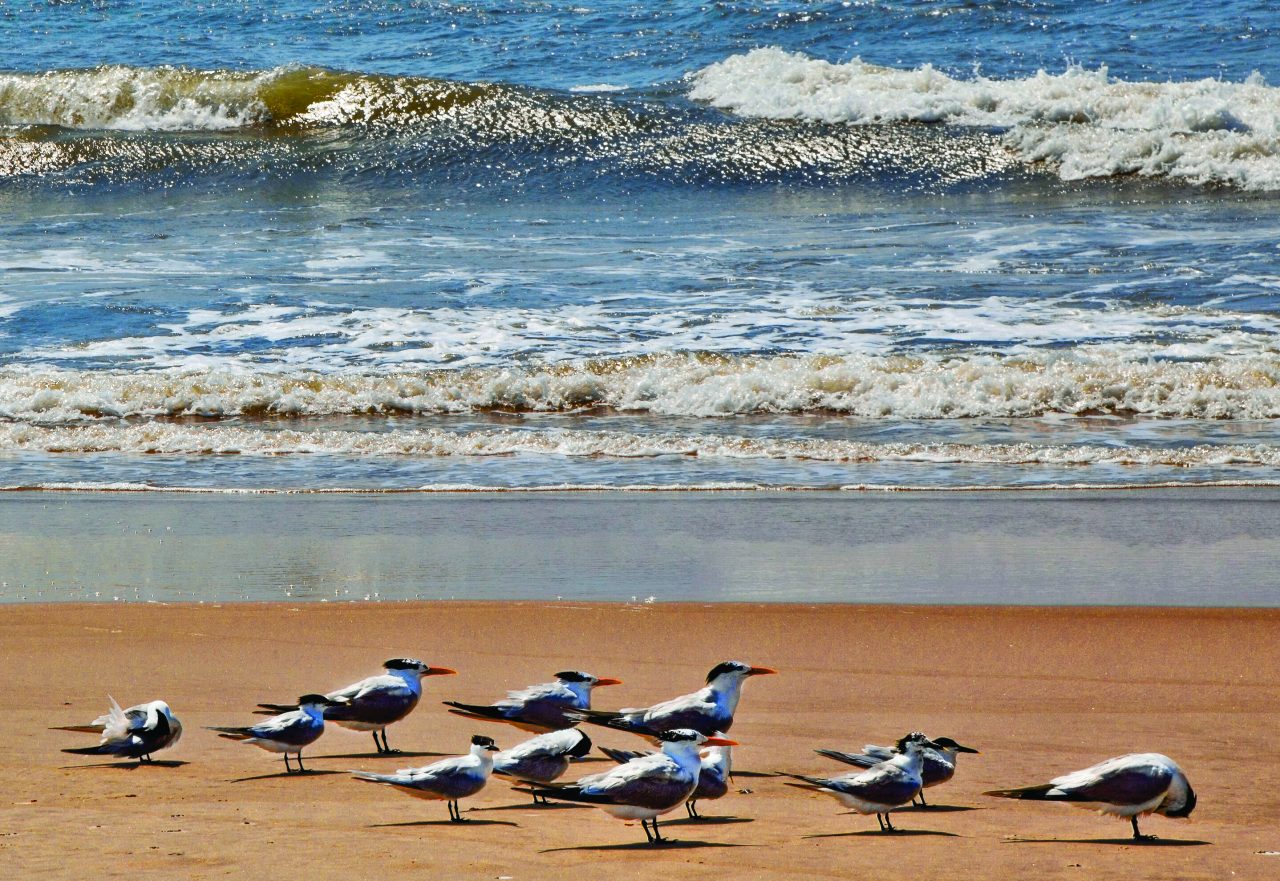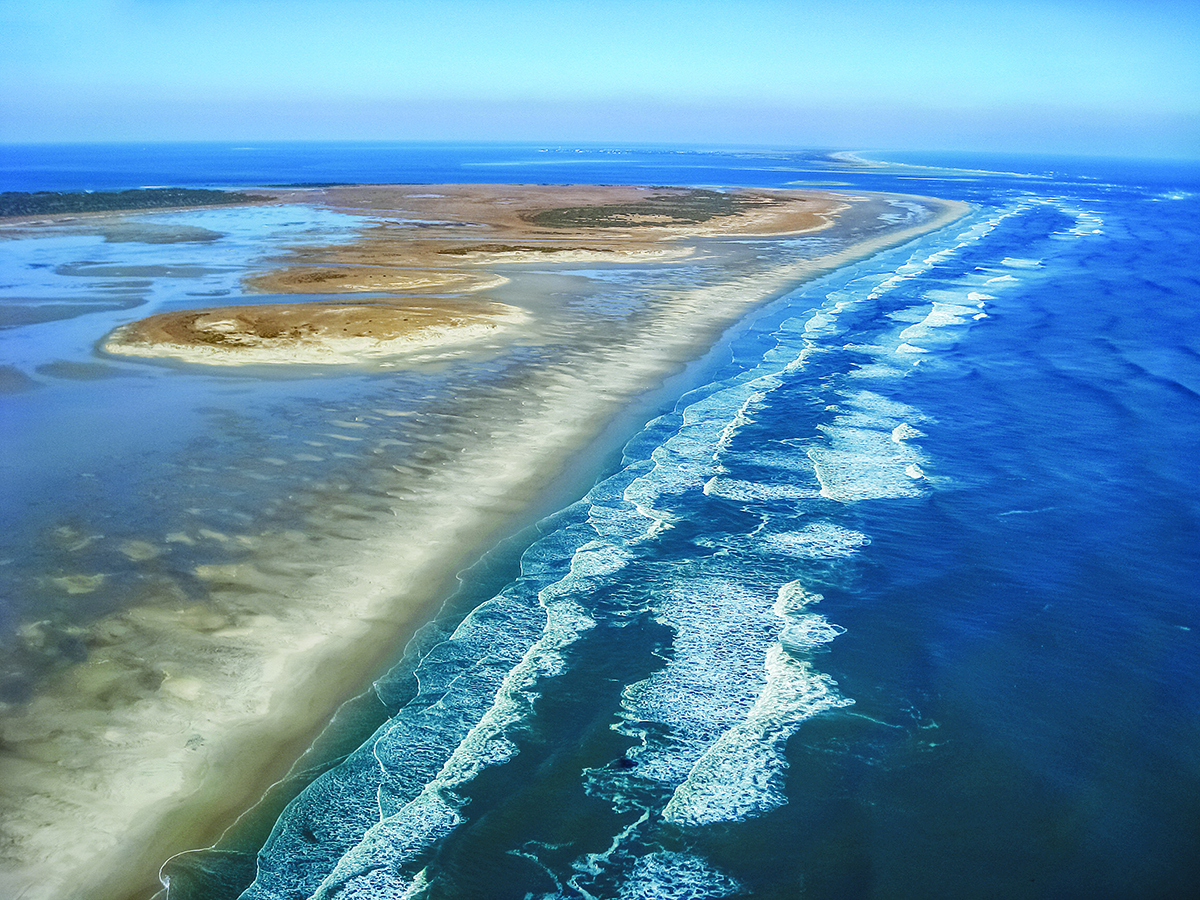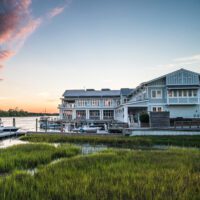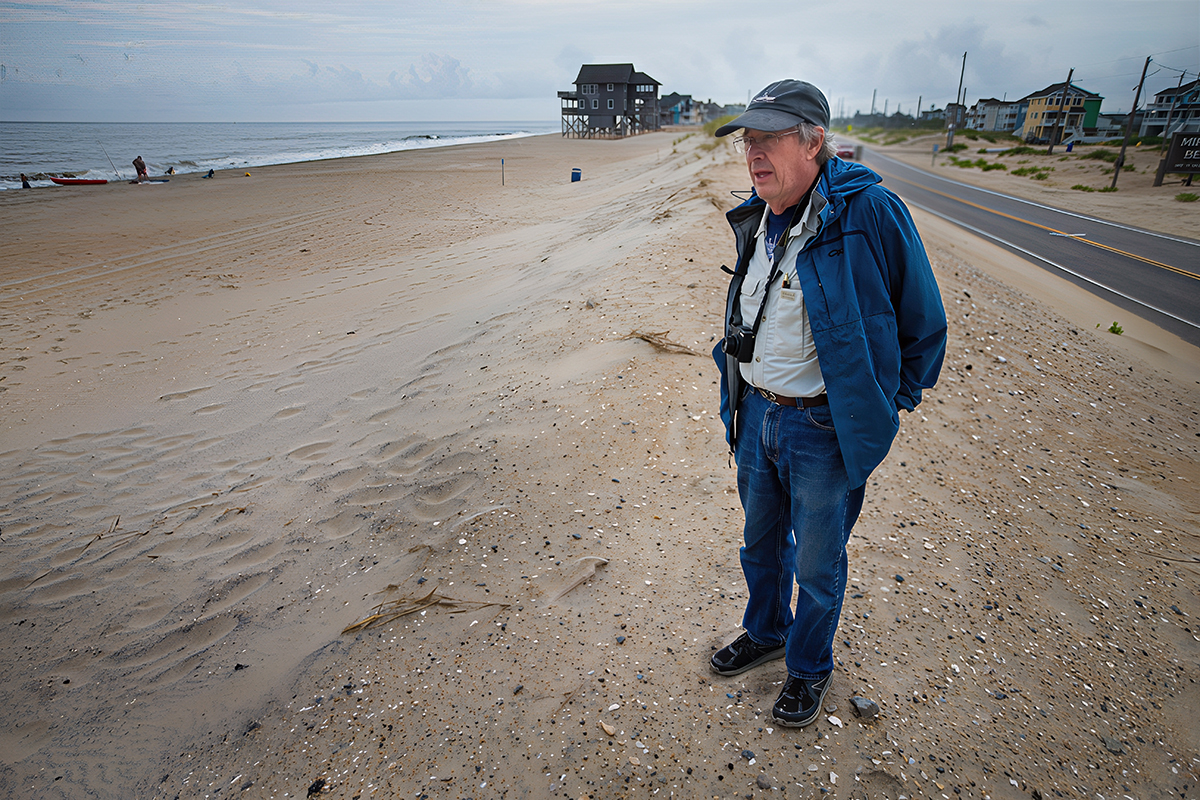
Editor’s note: Second in a series on the newest work by coastal geologist Stan Riggs, the following is an excerpt from “Cape Lookout National Seashore: Paradigm For A Coastal System Ethic.”
The book, with a foreword by conservationist Tom Earnhardt, a North Carolina Coastal Federation board member, is the first in the “North Carolina Land of Water” book series and focuses on the Cape Lookout National Seashore.
Supporter Spotlight
The nearly 300 photographs, maps and illustrations of shifting dunes, barrier islands and coastal wildlife are interwoven with carefully crafted maps and drawings, “tracing our coast from its ancient past through the centuries to our modern present,” according to NCLOW, the nonprofit founded by Riggs and fellow coastal geologist Dr. Dorothea V. Ames.
NCLOW’s stated mission “is to sustain NC’s dynamic water, land and air systems for generations to come.”
Land-Water-Air Interface: Nature’s Coastal Systems
I like to think that actively evolving coastal systems are like the human body with its totally interdependent array of subsystems: skeletal, muscular, circulatory, pulmonary, nervous, and endocrine systems driven by the incredible brain, heart, and lungs. It is difficult to live a healthy life without all these bodily components working intimately together. Likewise, our coastal system is dominated by an interdependent array of complex subsystems: landscapes, waterscapes, and airscapes all interacting at the land-water-air interface. The geographic conditions, geologic dynamics, meteorologic forces, and chemical-biological characteristics are critical variables that interact to produce a living, breathing, and evolving coastal system. Major coastal system drivers are the Earth’s physical landscape dynamics (uplifting of mountains and opening of ocean basins), its space partners (creating climatic zones and setting the waterscape and airscape into motion), and the life-giving energy from the almighty Sun (driving the hydrologic cycle and atmospheric circulation that dictates the resulting biosphere).
Throughout the world, wherever a water body (ocean, sea, lake, or river) meets the surrounding land, a coastal system occurs. Because all water bodies and land masses are uniquely different, no two coastal systems are alike. Rather, they each display the influence of multiple variables producing continuums of coastal system types. The landscape may be mountainous or low flatlands dominated by hard rock, sand and mud sediment, or rich and black organic matter; located in the polar, temperate, or tropical regions; or it may occur in a stable tectonic zone, an active earthquake zone, or an area dominated by volcanic activity. Likewise, the size, location, and physical-chemical-biological characteristics of the water body are also determining characteristics. A critical third component also occurs at every land-water intersection; this is the overlying atmosphere and its climatic characteristics that help determine the ultimate character and are the drivers of change for each coastal system.
Like the human body, coastal systems tend to be extremely dynamic, changing in response to energy input at several different time scales. Volcanic activity (Hawaiian Island coasts) and earthquakes (US Pacific coasts), the dominant sources of energy, occur over decades, centuries, and millennia. However, the energy input from atmospheric storm dynamics affects all coastal systems and is the dominant energy source along the US Atlantic and Gulf coasts, occurring at irregular but frequent short-term time scales. An extremely active atmosphere with rapidly changing climatic conditions is the overwhelming cumulative force that routinely produces short-term changes and long-term evolution associated with most southeastern US coastal systems. The ultimate driver of these climate systems and associated storms is our space partner, the Sun.
Supporter Spotlight
Natural Function of Barrier Islands: Limits to Growth, Development

Barrier islands and their associated water bodies have a set of dynamics that are established by the natural functions of Earth’s systems. The word “function” relative to the interactions between the land-water-air interface means assigned actions, activities, duties, or role. The function of interstate highways is to get vehicles from point A to point B very fast. Yes, I can ride my bike or have a picnic on an interstate, but it is guaranteed suicide for me to do so. I might instead ride a bike on a dead-end backcountry road or on a former railroad bed that has been disconnected from the grid, as these now have totally different functions. Rest areas with picnic tables and dog parks are already major components of most interstate highways and they might have separately constructed bike lanes in the future, but not today.
Absolute limits exist as to the number, size, and speed of vehicles that can use a one-lane dirt road. Absolute but different limits occur when it becomes a paved two-lane road. Soon the two-lane road becomes overwhelmed, and it is expanded to a four-lane highway, and with continued growth and development in expanding urban areas, it will evolve into six- and eight-lane segments. At some point in the situation of unlimited growth and development the function of each system will break down. Then society is generally forced to come up with new rules or zoning conditions essential for developing an upgraded or new roadway system that requires new land and higher-grade building materials for new types of vehicles that need higher speed limits, and so on.
Similar rules, or zoning, what I call geo-zoning or eco-zoning, must now be considered for natural landscapes, waterscapes, and airscapes confronted with the pressures of unlimited growth and development. The problem is that society generally sets economic rules concerning natural dynamics that maximize profits and minimize the cost of living. For example, many laws require state and federal contracts to go to the lowest bidder or require projects to have a certain cost-benefit ratio.
Often this requires that new roadways go straight through natural areas or over waterways. These laws also often eliminate or divide impoverished and minority urban areas, as well as promote minimum water drainage structures and shorter project life expectancies. Rarely do they take into consideration the cumulative impact or unintended consequences on complex, interdependent systems. In addition, a general lack of understanding of the scientific dynamics of many Earth systems leads directly to minimizing the use of scientific data relative to the economic impact of a project. Good societal and natural reasons exist for limits and constraints on our riding bikes on interstate highways; the same is true for living in active riverine floodplains, discharging waste into waterways, or building houses on ocean shorelines.

Barrier islands and their beaches are only mobile piles of sand at the intersection of land, water, and air. Yes, this is real estate that can be subdivided into house lots and developed from shore to shore. However, shoreline lots are not equal to those in the middle of an island since they are direct products of regular storm dynamics on the adjacent water body. A waterfront house for living is like camping on the interstate. The only good news is that your eventual demise will be a bit slower on the beach. With unlimited growth and development, all possible island lots are plotted, sold, and built on. This increased growth soon pressures us to replace our ferry boats with two-lane bridges that quickly become overloaded. Then new four-lane bridges are justified on the premise of the need to get more people safely off the islands during storms. Family beach cottages are rapidly replaced by big businesses that rise vertically as rental McMansions, condominiums, hotels, and full urbanization sets in.
Because sea level is rising and storms continue to impact the barrier islands with more people and larger shoreline structures attempting to prevent the shorelines from moving, beach sand begins to disappear. Pumping new sand onto the islands becomes essential, but it is soon gone even as the islands continue to be developed. The natural coastal system is now destabilized, requiring construction of groins, jetties, and bulkheads to desperately hold a beach and stop shoreline recession. Ultimately, the islands will be encased in steel, concrete, and rock walls with little to no sandy beach along an increasingly steeper shoreface.

When economic development wins the battle, with permanently fixed commercial islands in the ocean covered with urban accoutrements ranging from shopping malls to freshwater parks, the islands will have new economic functions. What happened to the barrier island with its unique natural functions and ecosystems associated with high energy sand beaches, dune fields, tide flats, and marshes that harbored the ghost crabs, sea turtles, and shorebirds? Natural barrier island limits have been violated by unlimited growth and development, and once again the stage is set for the perfect conflict between humans and their natural environment.
Similar to barrier islands, other geographic basins on Earth’s surface and in wet climatic zones (swamps, ponds, lakes, or ocean) have a function of holding water. If the geographic basin is linear and open-ended, its function might be to carry a moving flow of water, generally known as a river. Each type of water system has its own specific functions, each dictating different limits to contiguous growth and development.
Absolute limits to growth and types of development exist for high energy and mobile barrier island sand piles, riverine floodplains, swamp-forest pocosins, and estuarine marshes. Similarly, limits pertain to other landscapes, including the savage clear-cuts of the northwest US rain forests, excavations of Appalachian Mountain tops for coal, the vast deforestation of the Amazon jungle—these are all tracts of insatiable consumption driven by the indigenous American spirit monster of self-destruction. “Unlimited” human consumption has consequences; infinite growth on a finite planet is generally not compatible with natural law. We must embrace the radical notion that all of Earth’s natural resources and crucial ecosystem services are essential if we are to maintain a sustainable and high quality of life in society’s future.
Fortunately, some barrier islands, estuarine water bodies, riverine floodplains, and pocosin swamp forests have been protected from the perils of total modification and urbanization by establishing different forms of protected status such as national seashores, wildlife refuges, coastal preserves, state parks, and conservancy lands. The preservation of Cape Lookout National Seashore, or CALO in 1976 clearly demonstrates the critical interdependence between storm dynamics and the barrier island buffer zone. For these intermediary habitats to continue functioning as nature’s speed bumps, storms must unleash tremendous energy across the coastal wetlands—flooding marshes, reshaping shorelines, and maintaining the shifting sands of healthy barrier islands that buffer the uplands from the sea.
Developing a New Coastal System Ethic

In 1949, Aldo Leopold presented to the world his critical concept of a land ethic. This ethic was primarily focused on Earth’s land-based environments in general; it did not directly address either water or air as discreet components with equal voices to that of uplands. However, in the real world of our planet, land-water-air all form a crucial and highly interwoven trinity, a complex and totally integrated system of subsystems not unlike the human body or every other living organism whose component systems are interactive and interdependent parts of the whole. Society needs to apply Leopold’s land ethic to the total tripartite system of the whole Earth and its multitude of land-water-air based environments. One of the most dynamic parts of that system is the coastal component where the planet’s water world meets land, and wherever this occurs, the resultant climatic conditions tend to drive the energetic forces. This new variant of a coastal system ethic places boundaries around those regions where land and water meet
and operates in response to atmospheric dynamics. In these uniquely high energy regions where forces collide, change is dominant and will always prevail.







